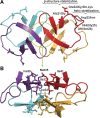Crystal structure of the amyloid-β p3 fragment provides a model for oligomer formation in Alzheimer's disease
- PMID: 21273426
- PMCID: PMC6623621
- DOI: 10.1523/JNEUROSCI.4259-10.2011
Crystal structure of the amyloid-β p3 fragment provides a model for oligomer formation in Alzheimer's disease
Abstract
Alzheimer's disease is a progressive neurodegenerative disorder associated with the presence of amyloid-β (Aβ) peptide fibrillar plaques in the brain. However, current evidence suggests that soluble nonfibrillar Aβ oligomers may be the major drivers of Aβ-mediated synaptic dysfunction. Structural information on these Aβ species has been very limited because of their noncrystalline and unstable nature. Here, we describe a crystal structure of amylogenic residues 18-41 of the Aβ peptide (equivalent to the p3 α/γ-secretase fragment of amyloid precursor protein) presented within the CDR3 loop region of a shark Ig new antigen receptor (IgNAR) single variable domain antibody. The predominant oligomeric species is a tightly associated Aβ dimer, with paired dimers forming a tetramer in the crystal caged within four IgNAR domains, preventing uncontrolled amyloid formation. Our structure correlates with independently observed features of small nonfibrillar Aβ oligomers and reveals conserved elements consistent with residues and motifs predicted as critical in Aβ folding and oligomerization, thus potentially providing a model system for nonfibrillar oligomer formation in Alzheimer's disease.
Figures





References
-
- Barghorn S, Nimmrich V, Striebinger A, Krantz C, Keller P, Janson B, Bahr M, Schmidt M, Bitner RS, Harlan J, Barlow E, Ebert U, Hillen H. Globular amyloid β-peptide oligomer—a homogenous and stable neuropathological protein in Alzheimer's disease. J Neurochem. 2005;95:834–847. - PubMed
-
- Barnham KJ, Cappai R, Beyreuther K, Masters CL, Hill AF. Delineating common molecular mechanisms in Alzheimer's and prion diseases. Trends Biochem Sci. 2006;31:465–472. - PubMed
-
- Brünger AT. Free R value: a novel statistical quantity for assessing the accuracy of crystal structures. Nature. 1992;355:472–475. - PubMed
MeSH terms
Substances
LinkOut - more resources
Full Text Sources
Other Literature Sources
Medical
